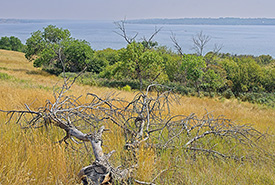A win for nature: A community’s determination for conservation in the Upper Qu’Appelle Valley

Last Mountain Lake, SK (Photo by Bill Armstrong)
The Nature Conservancy of Canada’s (NCC’s) newly acquired property in the Upper Qu’Appelle Valley — designated as Last Mountain Lake 1 — is relatively small compared to the other eight properties it manages in the area, but it is significant for several reasons. For one, this 41-hectare patch of grassland and riparian habitat is now protected from development in an area that is under pressure for residential, agricultural and commercial development. Even more important, perhaps, is that it required citizen engagement and patient, long-term commitment by people who recognized its value in its natural state to secure the property.
Last Mountain Lake is part of the Qu’Appelle Valley watershed, which runs from east central to southeastern Saskatchewan. It attracts many seasonal and full-time residents — and recreation seekers — because of its proximity to communities like Regina. The shoreline and hills above are dotted with cottages and all-season homes inhabited by people who appreciate the valley views. Last Mountain Lake 1 is located between a collection of a few homes known as Sun Dale, and a slightly larger community known as the Resort Village of Pelican Pointe. The property is a popular spot for hikers and nature lovers, and it is also important habitat for at-risk species, such as northern leopard frog, bobolink, horned and western grebe, Sprague’s pipit and little brown myotis.

Last Mountain Lake, SK (Photo by Bill Armstrong)
Perry Casson has lived at Pelican Pointe since 2013 and hikes on the property from early spring until late fall. He first heard there was a campground developer interested in buying the property and converting it to a seasonal “glamping” campsite in the summer of 2020. Perry and 11 other residents of Pelican Pointe came together, concerned about the loss of habitat but also the impact of additional traffic on the access road and pressure on infrastructure, such as water and sewer.
“We called ourselves the Last Mountain Neighbours Association (LMN) and created a website," Perry says. “There were a lot of ups and downs.”
The property is in the Rural Municipality of McKillop, but Pelican Pointe has its own council and does not pay taxes to the municipality. LMN reached out to other property owners to let them know about the development proposal.

Last Mountain Lake, SK (Photo by Bill Armstrong)
“An early action was to contact property owners, such as farmers, so that they were aware, and ask them to be vocal if they did not want the development,” Perry says. “In the summer of 2021, we circulated a petition that gathered about 280 signatures from local ratepayers to present to the municipality, which would make the decision on any application to rezone the land. We also began fundraising to purchase the land and reached out to NCC to explore the idea of donating the land to their non-profit organization.”
In the meantime, however, there was a string of down days for the group. In August 2021, the existing landowner made a conditional offer to the developer, preventing LMN from making an offer. Later, the association learned that the land title had transferred to the developer and that a portion of the property had been put up for sale.
“We were one RM Council vote away from a zoning change,” Perry reflects. Undeterred, the group continued to let the municipality know there were ratepayers who supported keeping the land as it was, and connected the developer to NCC to help facilitate a possible sale.

Last Mountain Lake, SK (Photo by Bill Armstrong)
After NCC identified the property’s ecological importance, they worked closely with the LMN Association and other local supporters to secure its future. The land purchase was only possible through the combined efforts of residents, supporters and NCC’s determination to conserve this critical habitat. Fundraising efforts began in earnest and, while significant progress has been made, there is still more work to do. The support of individuals who care about the Qu’Appelle Valley’s natural legacy is vital to closing the funding gap.
By coming together, we can ensure this special place remains protected for future generations. To contribute to its preservation, visit conservegrasslands.ca today.


